Experimental and Numerical Investigation of Geosynthetic-Reinforced Pile-Supported Embankments for Loose Sandy Soils
Abstract
:1. Introduction
2. Model Tests
2.1. Test Setup
2.2. Properties of Used Materials
2.3. A Small-Scale Model Construction
2.4. Instrumentation
2.5. Loading System and Test Procedures
2.6. Limitations and Considerations of the Study in a Scaled Lab Model
- The GRPS embankment model used in the experiment was scaled down to 1/10 of a typical field embankment size, including the embankment, piles, and spacing between piles. The tensile stiffness and strength of the geogrid were also reduced by a factor of 1/10. Furthermore, the area and force were scaled down by a factor of 1/100 to maintain proportional similarity with the original model [16].
- The experiment was conducted over a period of three days, which may have limited the study’s ability to fully capture potential long-term effects, such as the creep behavior of the geotextile.
- Load transfer to the piles may be influenced by friction between the side walls of the embankment and the soil. However, the embankment in the study was relatively small in height (150 mm), and a polytetrafluoroethylene (PTFE) material was used to minimize friction between the soil and the box walls. Therefore, any impact from side wall friction is expected to be negligible. Nonetheless, it is important to consider these limitations when interpreting the results of the study.
3. Model Simulation
4. Results and Discussion
4.1. Influence of Embankment Fill Properties (φ,c,E)
4.2. Influence of Horizontal Reinforcement
4.3. Influence of the Pile Cap Shape
4.4. Influence of Pile Length (L), Pile Diameter (d), and Cap Width (a)
- Case A: the volume is increased by utilizing a square-shaped cap with a thickness of 20 mm, while maintaining constant values for pile length (400 mm) and diameter (27 mm).
- Case B: the volume is boosted by increasing the diameter of the pile while keeping the length constant at 400 mm (without cap).
- Case C: The volume is increased by raising the length of the pile while keeping the diameter constant at 27 mm (without cap). Table 2 illustrates the changes of volume based on pile length and the corresponding parameters.
5. Conclusions
- ➢
- The embankment fill properties—internal friction angle and cohesion—contribute to the promotion of the soil-arching phenomenon, leading to an increased load transmit to the piles in the middle and on the sides under the embankment, while the impact of the elastic modulus is considered low.
- ➢
- The use of embankment fill with higher values for the internal friction angle and cohesion leads to a notable decrease of 46% and 37%, respectively, in maximum settlements at the base of the embankment. Moreover, this enhancement contributes to a reduction of 48% and 50%, respectively, in differential settlements.
- ➢
- The use of two layers of geotextile with optimal positions over the pile heads can improve load distribution and reduce variance in load efficiency between the piles, and consequently, lead to a 30% decrease in maximum settlements at the base of the embankment.
- ➢
- The load efficiency of a pile and the settlement of an embankment are directly influenced by the shape of the pile cap. In particular, a plus-shaped pile cap provides higher load efficiency for smaller areas, and the area of the pile cap is equal to three times that of the pile. Thereafter, this advantage diminishes as the pile cap area becomes larger. Conversely, squared and circular pile caps tend to function as shallow foundations, providing greater load efficiency for larger pile cap areas.
- ➢
- The use of a plus-shaped pile cap can result in a significant reduction of maximum settlements, especially when the pile cap area is smaller. On the other hand, squared and circular pile caps exhibit similar settlement behavior. Additionally, the utilization of pile caps can significantly reduce differential settlements when compared to other parameters.
- ➢
- Extending the pile length leads to a greater transfer of the load to the soil below. However, the use of capped piles contributes to further distribution of the load over the piles in the middle and on the sides.
- ➢
- Employing longer piles and capped piles results in a considerable reduction of maximum settlements. Moreover, capped piles significantly contribute to decreasing differential settlements.
Author Contributions
Funding
Data Availability Statement
Conflicts of Interest
References
- Raja, M.N.A.; Shukla, S.K. Ultimate bearing capacity of strip footing resting on soil bed strengthened by wraparound geosynthetic reinforcement technique. Geotext. Geomembr. 2020, 48, 867–874. [Google Scholar] [CrossRef]
- Raja, M.N.A.; Shukla, S.K. Experimental study on repeatedly loaded foundation soil strengthened by wraparound geosynthetic reinforcement technique. J. Rock Mech. Geotech. Eng. 2021, 13, 899–911. [Google Scholar] [CrossRef]
- Deb, K.; Sivakugan, N.; Chandra, S.; Basudhar, P.K. Generalized Model for Geosynthetic-Reinforced Granular Fill-Soft Soil with Stone Columns. Int. J. Geomech. 2007, 7, 266–276. [Google Scholar] [CrossRef]
- Han, J.; Gabr, M.A. Numerical Analysis of Geosynthetic-Reinforced and Pile-Supported Earth Platforms over Soft Soil. J. Geotech. Geoenviron. Eng. 2002, 128, 44–53. [Google Scholar] [CrossRef]
- Hewlett, W.; Randolph, M. Analysis of piled embankments. Ground Eng. 1988, 22, 12–18. [Google Scholar]
- Kempfert, H.; Gobel, C.; Alexiew, D.; Heitz, C. German recommendations for the reinforced embankments on pile-similar elements. In Geosynthetics in Civil and Environmental Engineering; Springer: Berlin/Heidelberg, Germany, 2004; pp. 697–702. [Google Scholar] [CrossRef]
- Abusharar, S.; Zheng, J.; Chen, B.; Yin, J. A simplified method for analysis of a piled embankment reinforced with geosynthetics. Geotext. Geomembr. J. 2009, 27, 39–52. [Google Scholar] [CrossRef]
- BS 8006; Code of Practice for Strengthened Reinforced Soils and Other Fills. BSI: London, UK, 2010. Available online: http://worldcat.org/isbn/0580242161 (accessed on 24 August 2023).
- EBGEO. Recommendations for Design and Analysis of Earth Structures Using Geosynthetic Reinforcements; German Geotechnical Society: Essen, Germany, 2011. [Google Scholar]
- Van Eekelen, S.; Bezuijen, A.; VanTol, A. An analytical model for arching in piled embankments. Geotext. Geomembr. 2013, 39, 78–102. [Google Scholar] [CrossRef]
- Pham, T. Analysis of geosynthetic-reinforced pile-supported embankment with soil-structure interaction models. Comput. Geotech. 2020, 121, 103438. [Google Scholar] [CrossRef]
- Alsirawan, R.; Koch, E.; Alnmr, A. Proposed Method for the Design of Geosynthetic-Reinforced Pile-Supported (GRPS) Embankments. Sustainability 2023, 15, 6196. [Google Scholar] [CrossRef]
- Nuñez, M.; Dias, D.; Kastner, R.; Poilpré, C. Soft Ground Improved by Rigid Vertical Piles. Experimental and Numerical Study of Two Real Cases in France. In Proceedings of the International Conference on Case Histories in Geotechnical Engineering, Arlington, VA, USA, 11–16 August 2008; Missouri University of Science and Technology: Rolla, MO, USA, 2008. [Google Scholar]
- Chevalier, B.; Villard, P.; Combe, G. Investigation of Load Transfer Mechanisms in Geotechnical Earth Structures with Thin Fill Platforms Reinforced by Rigid Inclusions. Int. J. Geomech. 2010, 11, 239–250. [Google Scholar] [CrossRef]
- Van Eekelen, S.; Bezuijen, A.; Lodder, H.; Van Tol, A. Model experiments on piled embankments. Part I. Geotext. Geomembr. 2012, 32, 69–81. [Google Scholar] [CrossRef]
- Xu, C.; Song, S.; Han, J. Scaled model tests on influence factors of full geosynthetic-reinforced pile-supported embankments. Geosynth. Int. 2016, 23, 140–153. [Google Scholar] [CrossRef]
- Pham, T.; Dias, D. 3D numerical study of the performance of geosynthetic-reinforced and pile-supported embankments. Soils Found. 2021, 61, 1319–1342. [Google Scholar] [CrossRef]
- Briançon, L.; Simon, B. Pile-supported embankment over soft soil. Geosynth. Int. 2017, 24, 293–305. [Google Scholar] [CrossRef]
- Kerry Rowe, R.; Liu, K. Three-dimensional finite element modelling of a full-scale geosynthetic-reinforced, pile-supported embankment. Can. Geotech. J. 2015, 52, 2041–2054. [Google Scholar] [CrossRef]
- Pham, T.; Tran, Q.A.; Villard, P.; Dias, D. Numerical Analysis of Geosynthetic-Reinforced and Pile-Supported Embankments Considering Integrated Soil-Structure Interactions. Geotech. Geol. Eng. 2023, 24, 1–22. [Google Scholar] [CrossRef]
- Alsirawan, R.; Koch, E. Behavior of embankment supported by rigid inclusions under static loads-parametric study. In Proceedings of the 12th IEEE International Conference on Cognitive Infocommunications—CogInfoCom 2021, Online, 23–25 September 2021; pp. 385–389. [Google Scholar]
- Hello, B.; Villard, P. Embankments reinforced by piles and geosynthetics—Numerical and experimental studies dealing with the transfer of load on the soil embankment. Eng. Geol. 2009, 106, 78–91. [Google Scholar] [CrossRef]
- Zhang, Z.; Wang, M.; Ye, G.; Han, J. A novel 2D-3D conversion method for calculating maximum strain of geosynthetic reinforcement in pile-supported embankments. Geotext. Geomembr. 2019, 47, 336–351. [Google Scholar] [CrossRef]
- Wang, T.; Nguyen, V.; Bui, P.; Luo, Q.; Liu, K.; Zhang, L. Three-dimensional physical modeling of load transfer in basal reinforced embankments under differential settlement. Geotext. Geomembr. 2023, 51, 330–341. [Google Scholar] [CrossRef]
- Pongsivasathit, S.; Chai, J.; Bergado, D. Laboratory model test on the behavior of floating soil-cement column improved ground. In Proceedings of the 14th Asian Regional Conference on Soil Mechanics and Foundation Engineering, Hong Kong, China, 23–27 May 2011. [Google Scholar]
- Cao, W.; Zheng, J.; ZhangRong-Jun Zhang, R.; Zhang, R. Field test of a geogrid-reinforced and floating pile-supported embankment. Geosynth. Int. 2016, 23, 348–361. [Google Scholar] [CrossRef]
- Zhang, H.; Wang, H.; Li, X.; Li, W.; Wu, J.; Lv, C.; Song, X.; Liu, M. An Analysis of Floating Geogrid-Reinforced Pile-Supported Embankments Containing Deep Softened Soil. Arab. J. Sci. Eng. 2021, 46, 10855–10868. [Google Scholar] [CrossRef]
- Shen, P.; Xu, C.; Han, J. Geosynthetic-reinforced pile-supported embankment: Settlement in different pile conditions. Geosynth. Int. 2021, 27, 315–331. [Google Scholar] [CrossRef]
- Esmaeili, M.; Khajehei, H. Mechanical behavior of embankments overlying on loose subgrade stabilized by deep mixed columns. J. Rock Mech. Geotech. Eng. 2016, 8, 651–659. [Google Scholar] [CrossRef]
- EN ISO 14688-1; Geotechnical Investigation and Testing—Dentification and Classification of Soil—Part 1: Identification and Description. International Organization for Standardization: Geneva, Switzerland, 2002.
- Hegde, A.; Sitharam, T. 3-Dimensional numerical modelling of geocell reinforced sand beds. Geotext. Geomembr. 2015, 43, 171–181. [Google Scholar] [CrossRef]
- Yang, X.; Han, J.; Parsons, R.; Leshchinsky, D. Three-dimensional numerical modeling of single geocell-reinforced sand. Front. Architect. Civ. Eng. 2010, 4, 233–240. [Google Scholar] [CrossRef]
- Ari, A.; Misir, G. Three-dimensional numerical analysis of geocell reinforced shell foundations. Geotext. Geomembr. 2021, 49, 963–975. [Google Scholar] [CrossRef]
- Terzaghi, K.; Peck, R.; Mesri, G. Soil Mechanics in Engineering Practice; John Wiley and Sons: New York, NY, USA, 1996. [Google Scholar]
- Stuart, J. Interference Between Foundations, with Special Reference to Surface Footings in Sand. Géotechnique 1962, 12, 15–22. [Google Scholar] [CrossRef]
- Alnmr, A.; Alsirawan, R. Numerical Study of the Effect of the Shape and Area of Shallow Foundations on the bearing Capacity of Sandy Soils. Acta Polytech. Hung. 2023, 12, 693. [Google Scholar]
- Jamsawang, P.; Yoobanpot, N.; Thanasisathit, N.; Voottipruex, P.; Jongpradist, P. Three-dimensional numerical analysis of a DCM column-supported highway embankment. Comput. Geotech. 2016, 72, 42–56. [Google Scholar] [CrossRef]
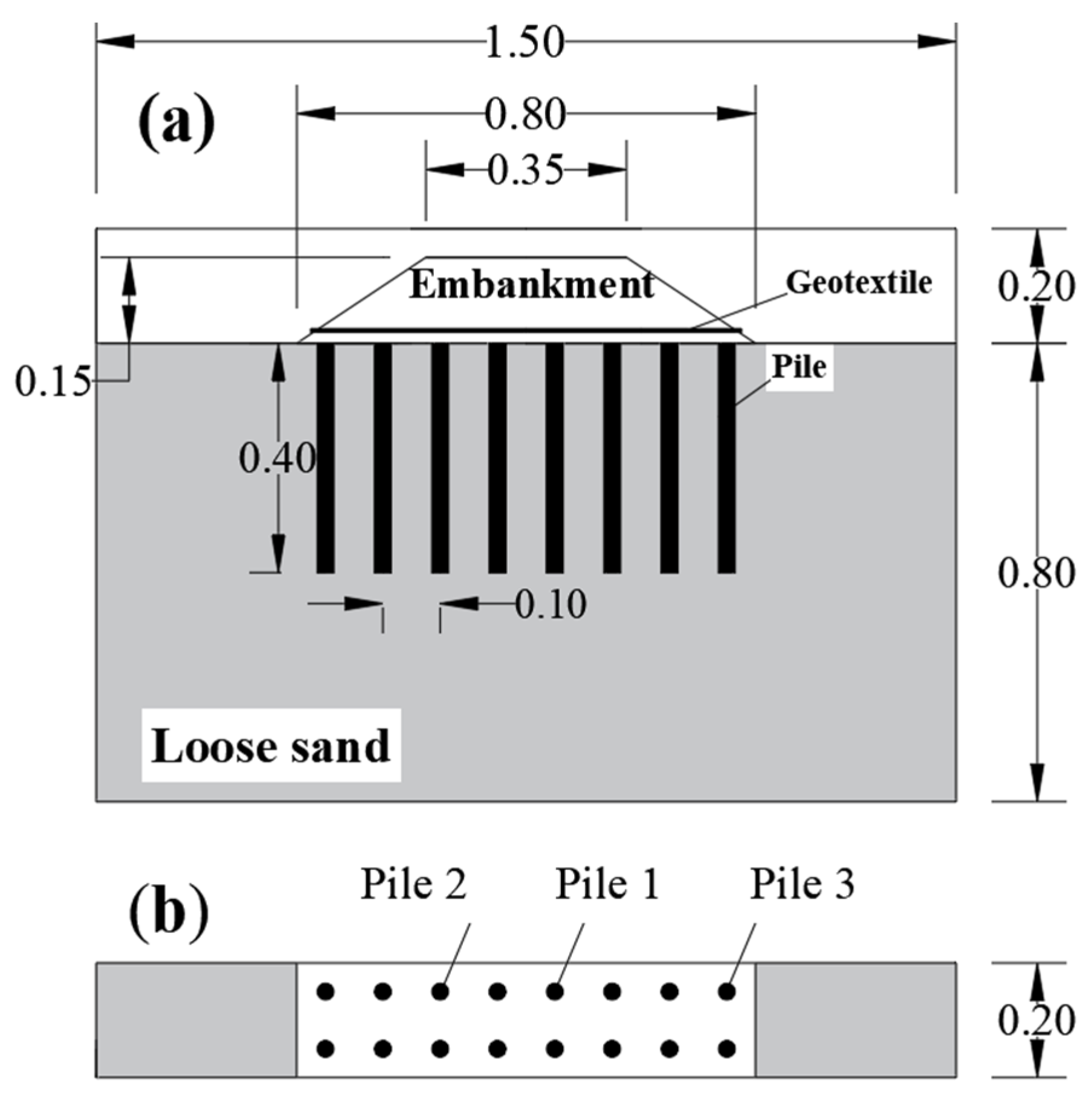



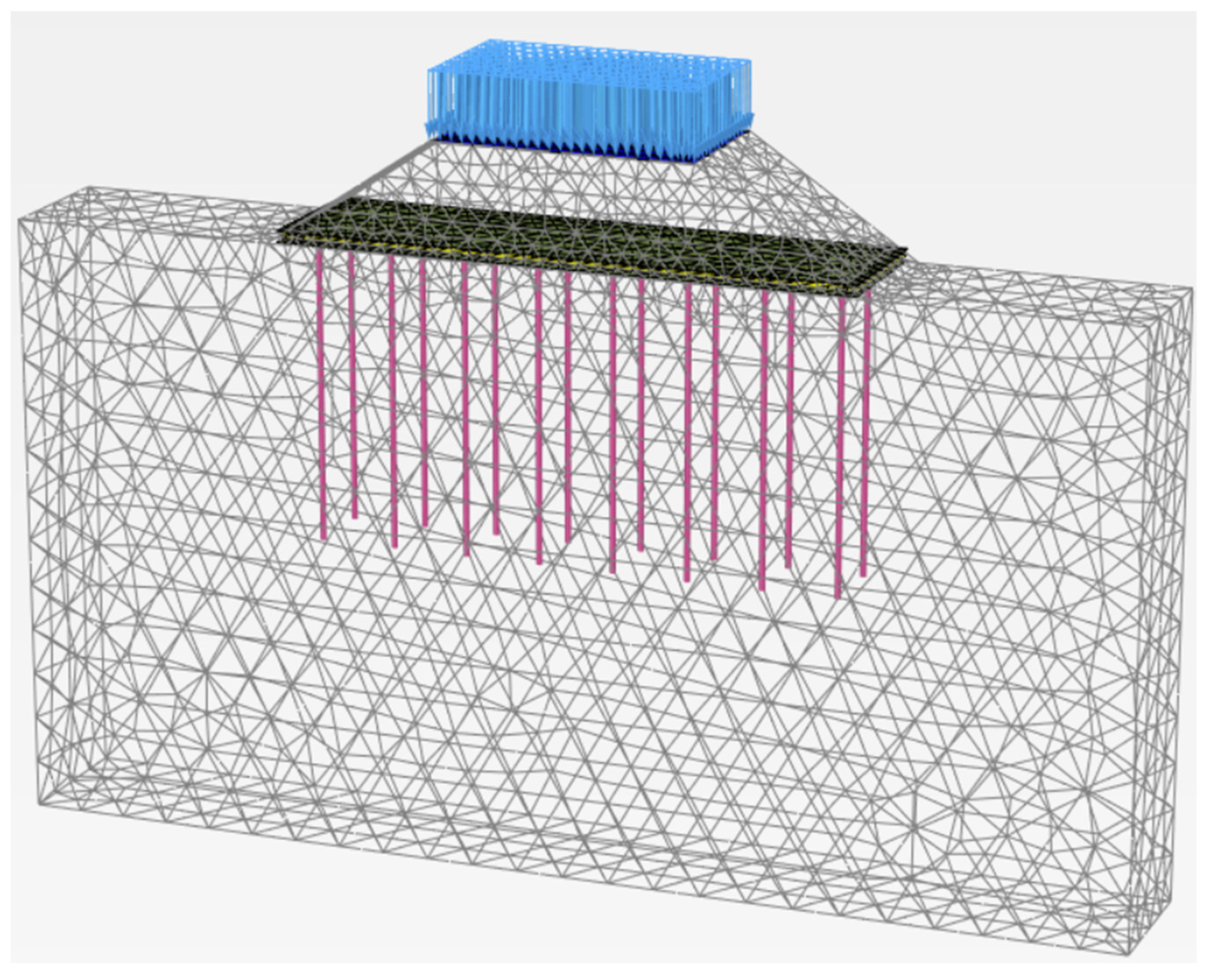


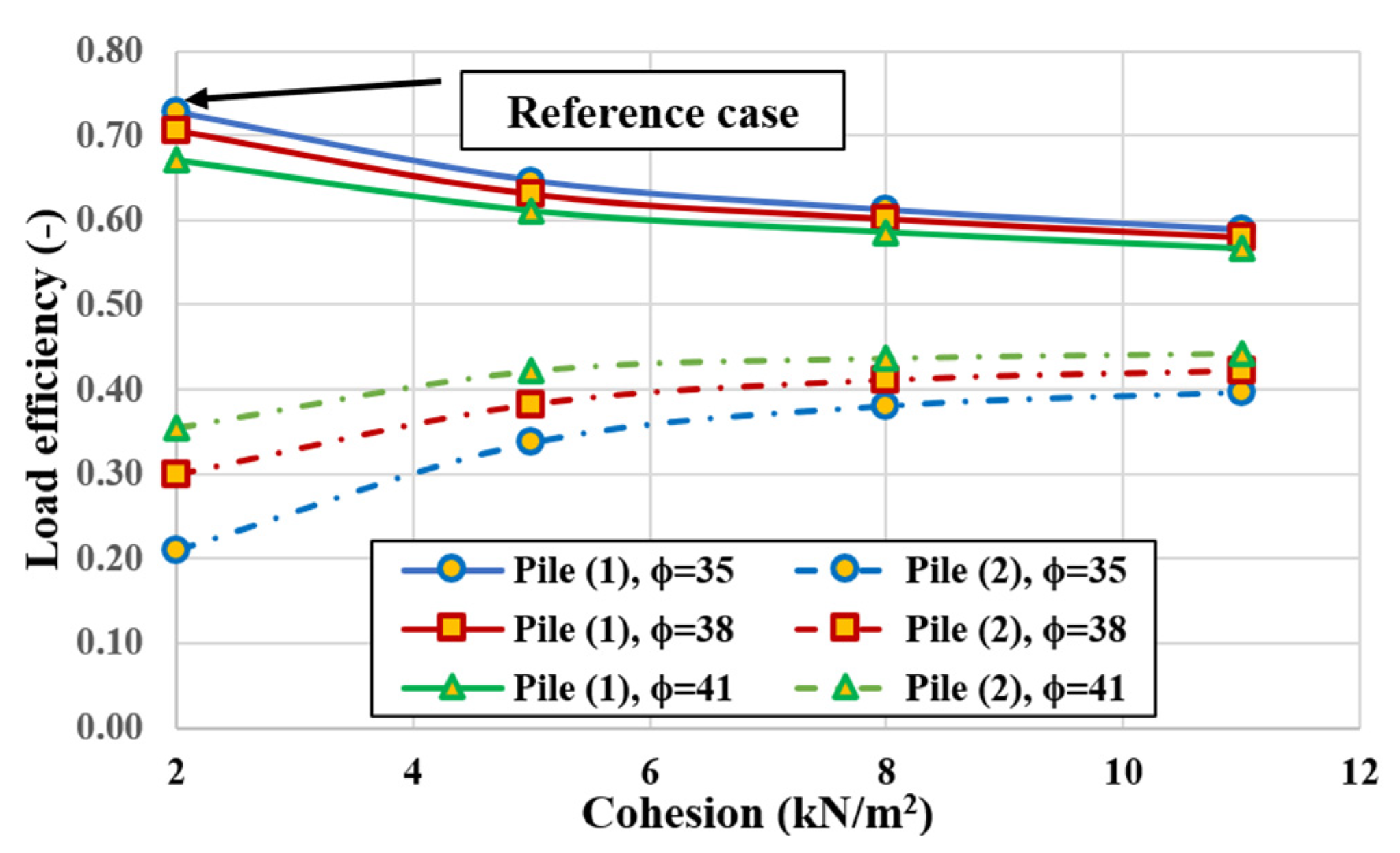
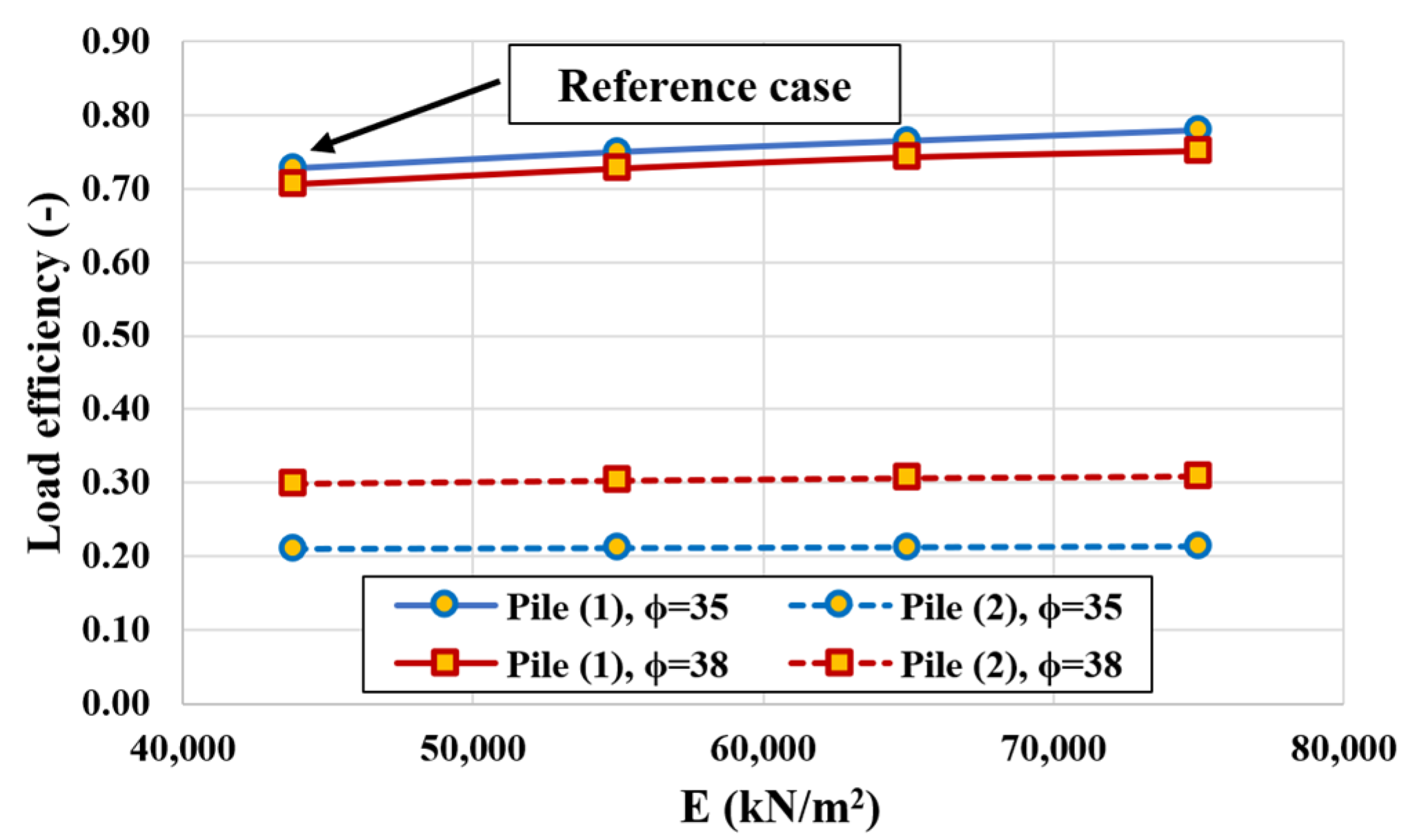
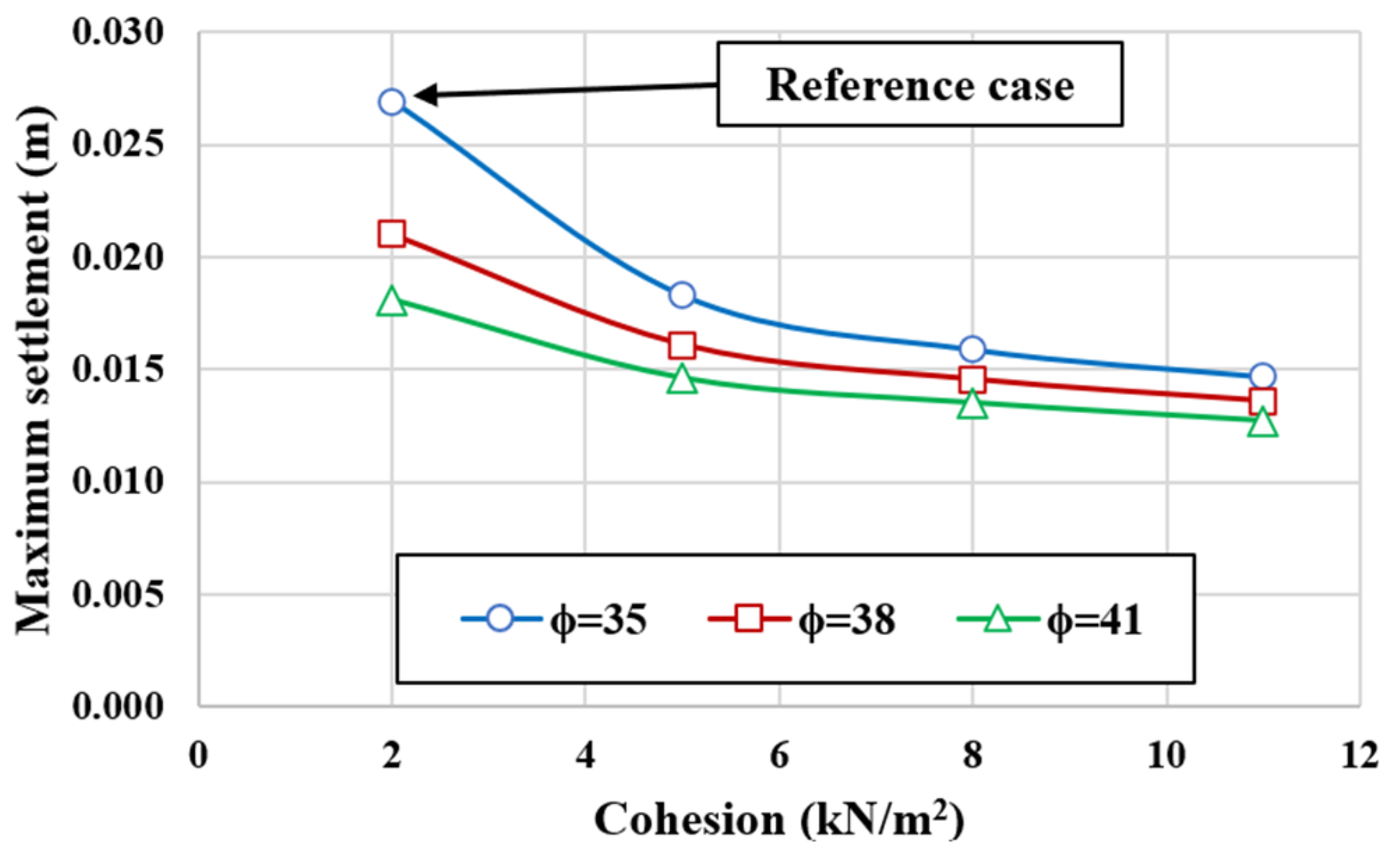
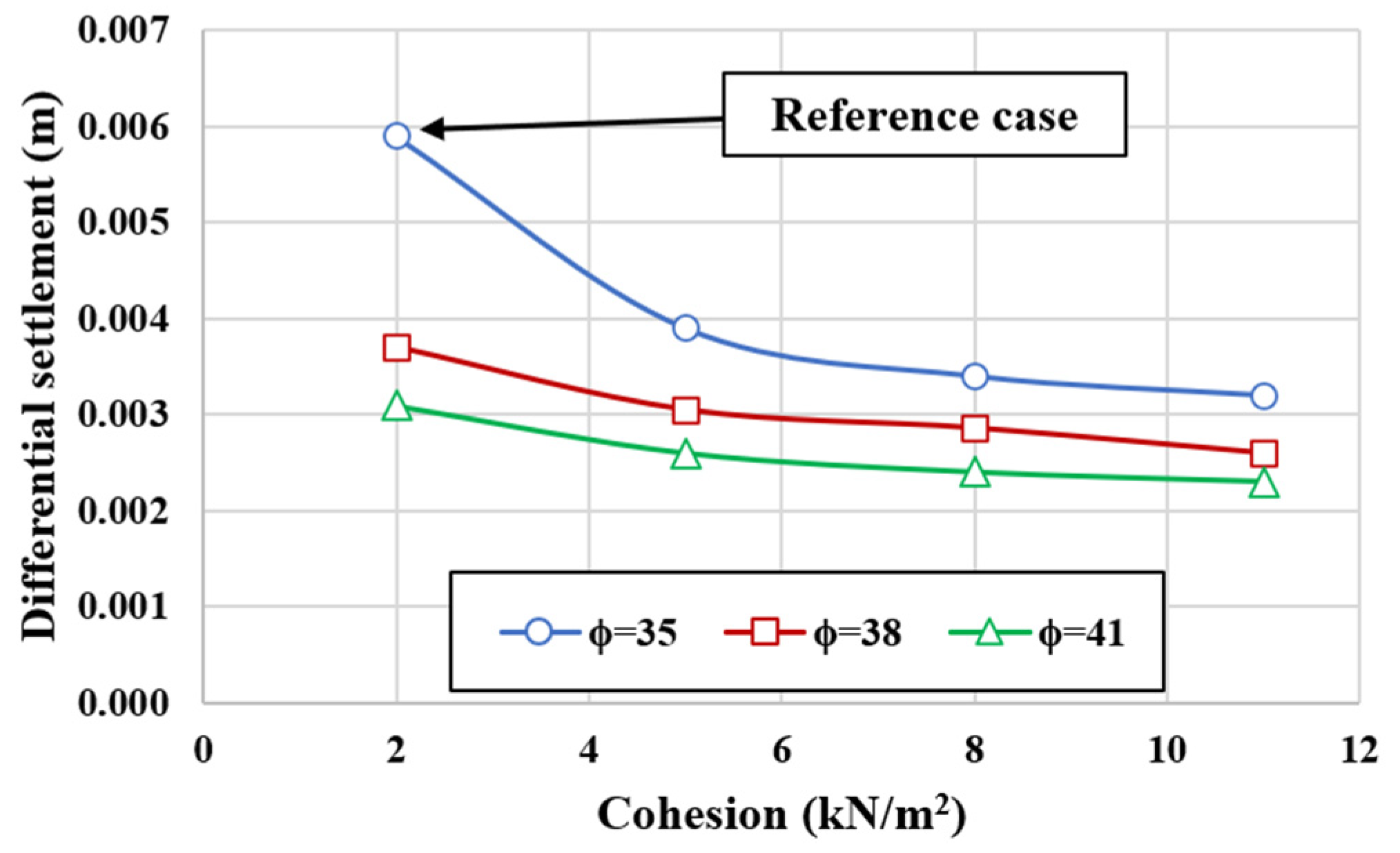
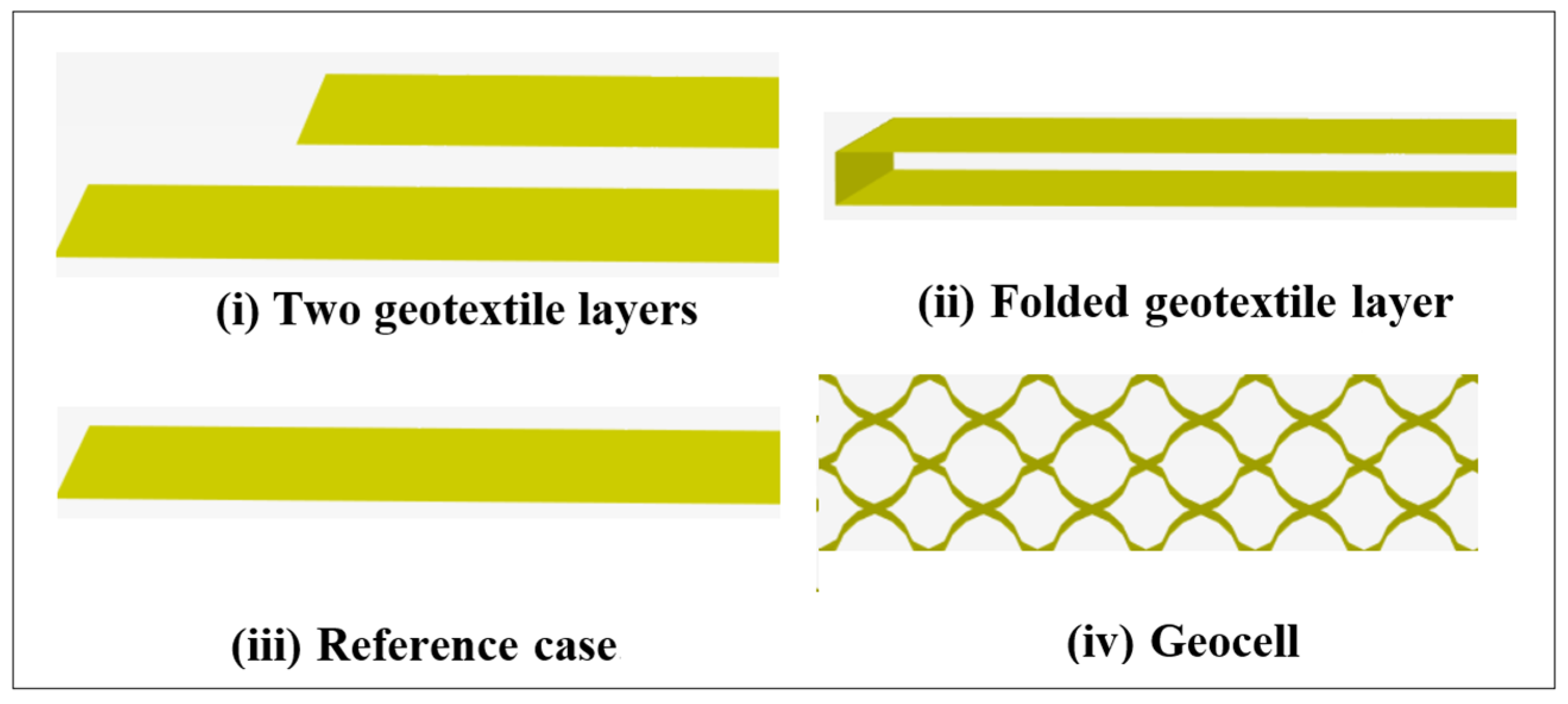
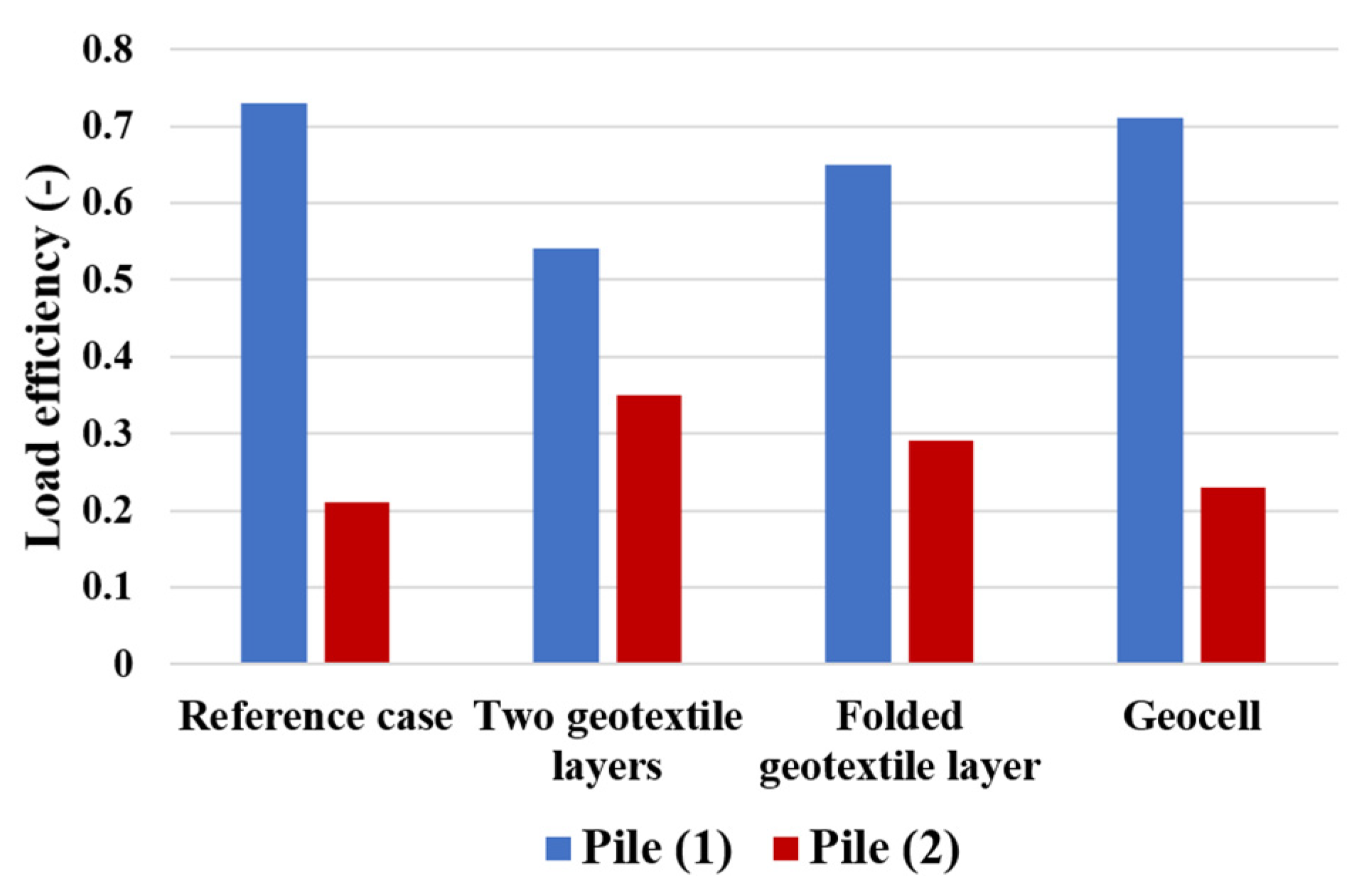



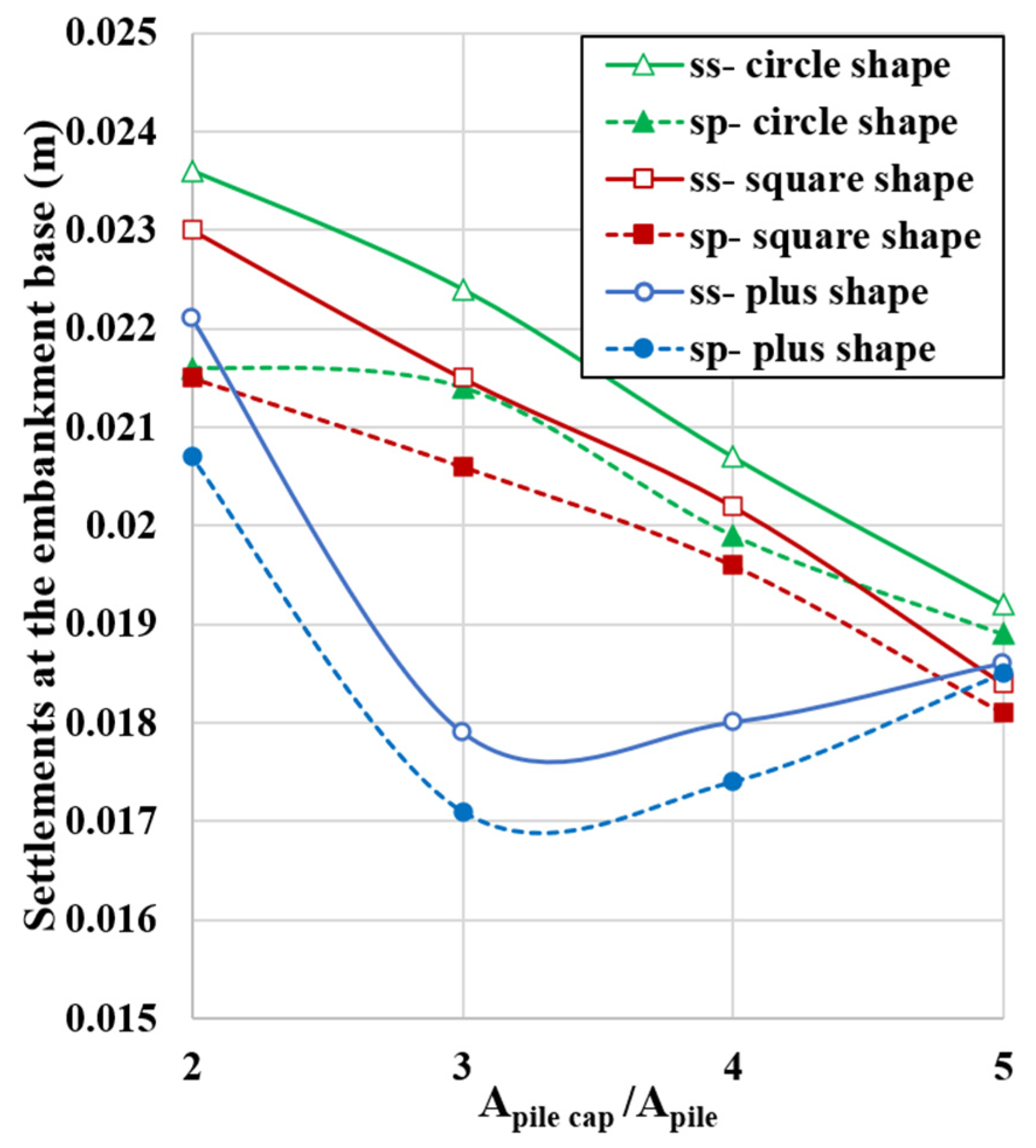
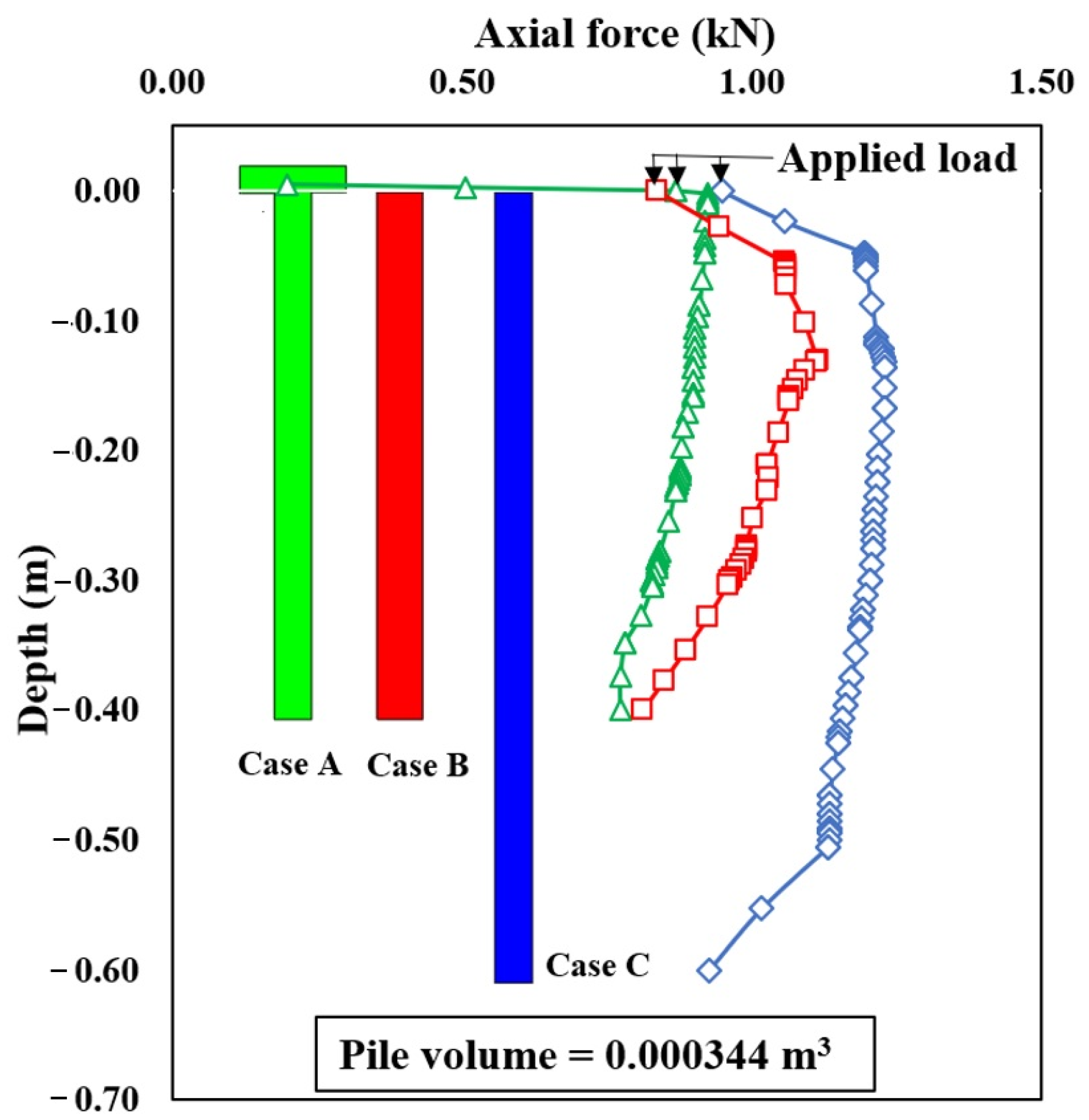

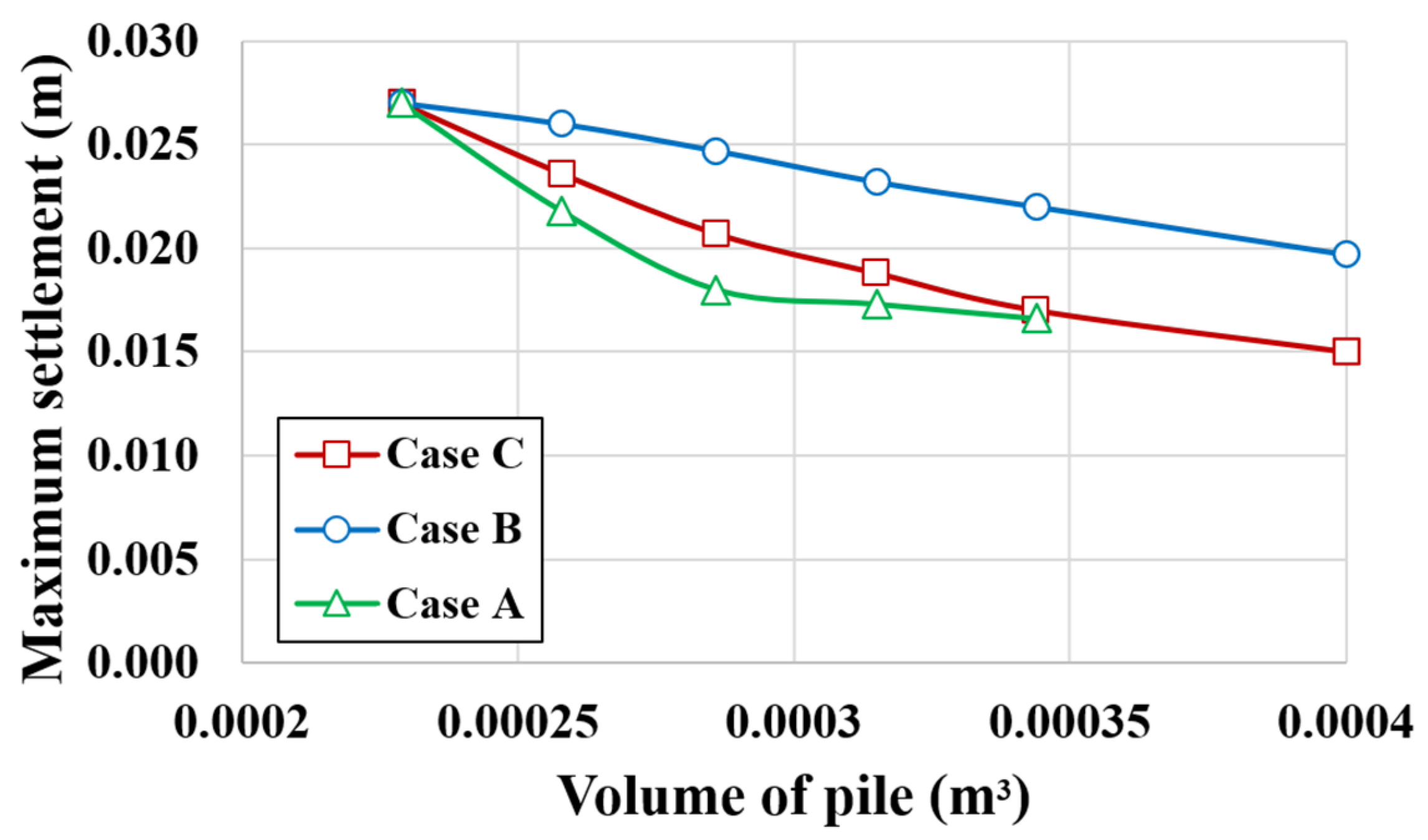
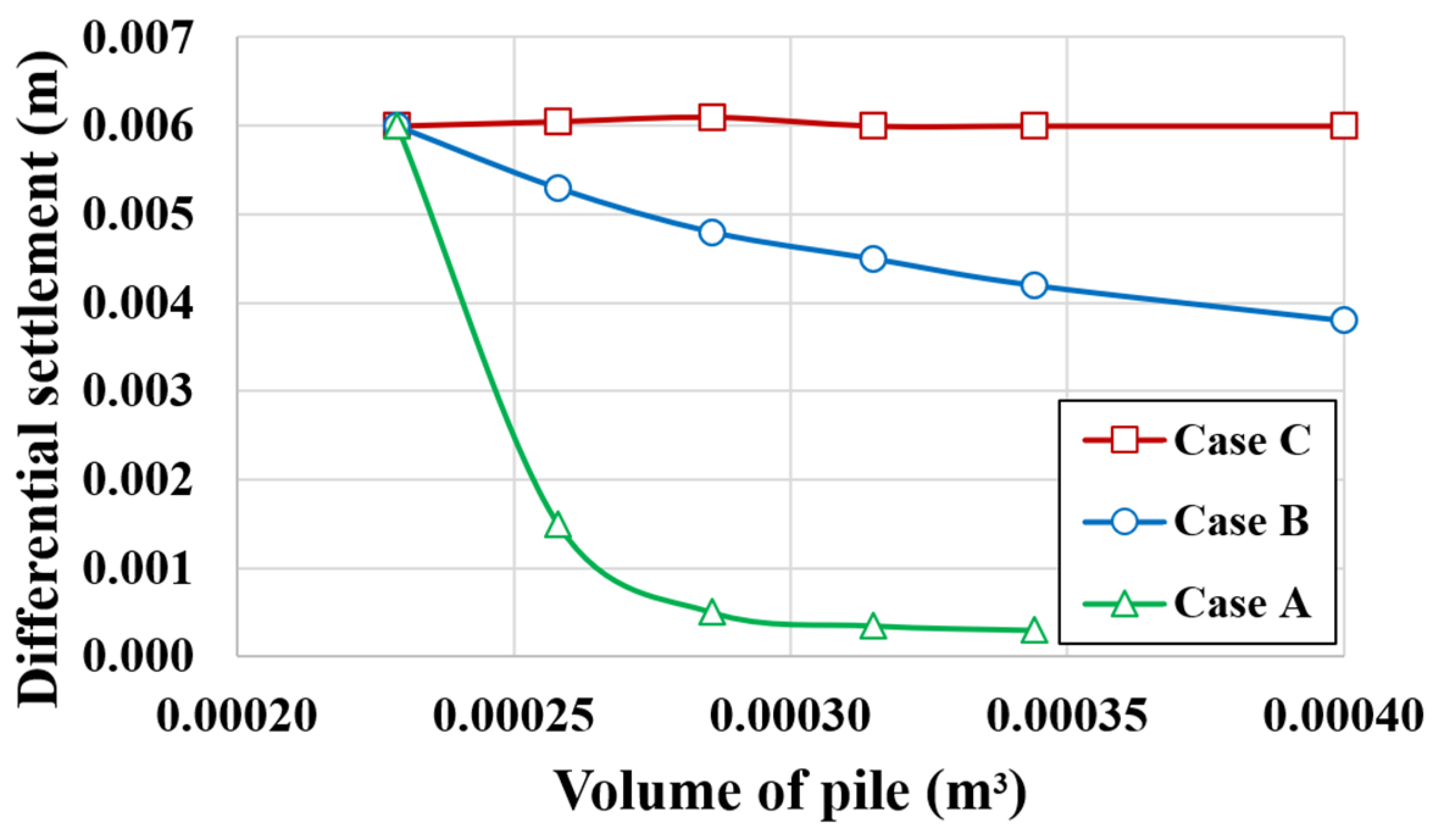
| Basic Parameters | Characters and Units | Embankment Soil | Sandy Soil |
|---|---|---|---|
| Dry unit weight | (kN/m3) | 18.0 | 15.2 |
| Angle of internal friction | 35.0 | 25.2 | |
| Dilatancy angle | 5.0 | 0.0 | |
| Cohesion | c (kPa) | 2.0 | 0.0 |
| Secant modulus | (kN/m2) | 43,830 | 17,220 |
| Oedometric modulus | (kN/m2) | - | 15,120 |
| Unloading/reloading modulus | (kN/m2) | 155,250 | 56,825 |
| Stiffness moduli correspond to confining pressure of 100 kPa. | |||
| Pile Length (m) | Volume (m3) | Corresponding Pile Diameter (m) | Corresponding Cap Width (m) |
|---|---|---|---|
| 0.4 | 0.000229 | 0.0270 | 0.0270 |
| 0.45 | 0.000258 | 0.0286 | 0.038 |
| 0.5 | 0.000286 | 0.0301 | 0.053 |
| 0.55 | 0.000315 | 0.0317 | 0.066 |
| 0.6 | 0.000344 | 0.033 | 0.076 |
| 0.7 | 0.0004 | 0.0357 | - |
| d = 27 mm, no cap | L = 400 mm, no cap | L = 400 mm, d = 27 mm |
Disclaimer/Publisher’s Note: The statements, opinions and data contained in all publications are solely those of the individual author(s) and contributor(s) and not of MDPI and/or the editor(s). MDPI and/or the editor(s) disclaim responsibility for any injury to people or property resulting from any ideas, methods, instructions or products referred to in the content. |
© 2023 by the authors. Licensee MDPI, Basel, Switzerland. This article is an open access article distributed under the terms and conditions of the Creative Commons Attribution (CC BY) license (https://creativecommons.org/licenses/by/4.0/).
Share and Cite
Alsirawan, R.; Alnmr, A.; Koch, E. Experimental and Numerical Investigation of Geosynthetic-Reinforced Pile-Supported Embankments for Loose Sandy Soils. Buildings 2023, 13, 2179. https://doi.org/10.3390/buildings13092179
Alsirawan R, Alnmr A, Koch E. Experimental and Numerical Investigation of Geosynthetic-Reinforced Pile-Supported Embankments for Loose Sandy Soils. Buildings. 2023; 13(9):2179. https://doi.org/10.3390/buildings13092179
Chicago/Turabian StyleAlsirawan, Rashad, Ammar Alnmr, and Edina Koch. 2023. "Experimental and Numerical Investigation of Geosynthetic-Reinforced Pile-Supported Embankments for Loose Sandy Soils" Buildings 13, no. 9: 2179. https://doi.org/10.3390/buildings13092179








